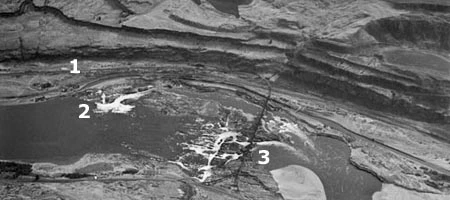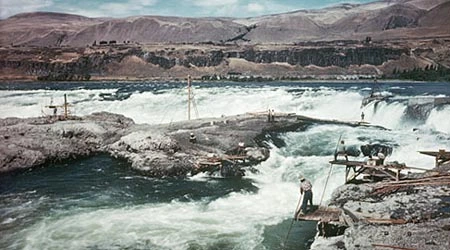Celilo Falls has always been phantom of history to me, since I born a few years after the U.S. Army Corps of Engineers buried the falls behind The Dalles Dam in 1957. My understanding of the falls and the loss it now represents has come from old photos and maps, and a few shaky film images.

The railroad bridge in the background of this iconic view is the key to locating the falls today
Yet for many, the falls and the native culture surrounding them are alive and vibrant in their memories, thanks to seeing and experiencing them first-hand. For Native Americans, the vivid memories only add to the pain of losing a place that quite literally defined a people for millennia.
The idea of restoring the falls — even temporarily — has been suggested over the years, usually to be slapped down quickly by the Corps of Engineers as unfeasible, or even dangerous. In the late 1980s, a brief, 30th anniversary movement to temporarily draw down the pool behind the dam briefly gained local momentum before the federal agencies killed any talk of the idea. The Corps likely realized that revealing the falls to the public even once could make it politically impossible to ever refill the dam again.

This 1940s aerial view shows the falls and railroad bridge, looking south
The hostility of the federal agencies toward even acknowledging the falls fanned the rumors among the local tribes that the falls had, in fact, been purposely destroyed by the Corps of Engineers just before they were inundated. This rumor persisted until last year, when a new mindset among Corps managers spurred the agency to compile a comprehensive sonar map of the falls to show that they are quite intact, beneath the still surface of the reservoir.
The sonar confirmation of the intact falls has breathed new life into the hopes of many that the falls will not just someday be restored, but perhaps someday soon. This is where the restoration of Celilo Falls fits within the scope of the MHNP Campaign: the emerging environmental theme in the coming century is restoration, and no place in the Pacific Northwest is more deserving — perhaps even the nation, considering that 11,000 years of Native American culture at Celilo makes it the oldest continuously settled place in North America.

This map clip correlates today's landmarks to the aerial view of the falls, above
But the connection to Mount Hood is even more elemental: the mountain towers over the Celilo country like a beacon, and has been a similarly important feature in the culture of Lower Columbia tribes. Celilo and WyEast are connected, and so their restoration should be. A joined effort to heal these places expands the possibilities for both.
What will a restored Celilo Falls look like? Initially, it will likely be mineral-stained and muddy. But the new sonar maps confirm that silts have not overtaken the falls, so if the pool behind The Dalles Dam were simply lowered today, we would see a largely intact falls — perhaps even with traces of the cantilevered dip net fishing structures that once clung to the rocks around the falls. And over time, the falls would quickly recover to blend again with the surrounding landscape.

R. Swain Gifford's 1875 etching of Mount Hood towering over the Celilo Narrows is among the earliest geographically accurate renderings of the area
What would a restored Celilo Falls mean for the mid-Columbia economy? The immediate impact would be on power supplies, and it is unlikely that the falls could ever be restored without some alternate energy supply — perhaps a wind farm of equal wattage? — ensuring that no net loss in energy production would result.
The next big question would be impacts on shipping, but the good news here is that barges were already using the Celilo Canal to bypass the falls long before the dam was erected. The canal system would conceivably resume this function, if the falls were reborn, albeit with likely improvements and modernization.

These scene was photographed in the mid-1950s, just before the falls was inundated
What kind of protection should the restored Celilo Falls receive? That part is easy. The astonishing scope of history tied to the falls easily qualify the site for World Heritage status within the U.S. National Park System, perhaps as a National Historic Site. This would put the restored falls in a category with places like Mesa Verde, in Colorado, and provide the needed framework to preserve and understand the historic resources that lie beneath today’s reservoir.
Restoration of Celilo Falls is a long-term dream of so many, but movement in that direction really began as soon as the falls disappeared in 1957. The falls has never left our collective consciousness, and thus demands restoration.
Another small step toward restoration will occur in 2009, when the commemorative Confluence Project will bring an art installation to Celilo. The project is marking the two centuries since Lewis and Clark passed through the region, and the millennia of human history that makes Celilo unique. A small step, but also a bit more progress toward what I believe will be the inevitable restoration of Celilo Falls — under the gaze of a restored Mount Hood.
Beautifully done! Restoring Celilo Falls has been a dream of mine for more years than I can remember. Before the Celilo Stories conference on the 50th anniversary of the drowning of the Falls, I had met resistence from those whose support I wanted most.
Then a small miracle occurred. Charles Wilkinson, a hero of mine for his brilliant condemnation of the Lords of Yesterday, pillagers of public resources ~ and a hero to the Salmon People for his undying devotion to righting the wrongs against them ~ came out in his keynote address in support of permanently drawing down The Dalles Dam and restoring Celilo Falls. Imagine the goosebumps that raced up and down my spine when he told me, immediately after his speech, that it was the Celilo Falls post on my personal website (www.david.hedges.name) that caused him to rethink his previous opposition.
I fully understand why some tribal elders hold with leaving things as they are, but Wilkinson has nudged many toward viewing restoration in a new light. This is not simply a Native American issue. It involves everyone, and has a bearing on our future as a species. Each small step moves us closer to the inevitable restoration of Planet Earth. Bravo!
LikeLike
Excellent post. I would love seeing Celilo Falls again.
About the comment regarding the shipping canal, there is one catch and it involves the railroad bridge. After the falls were flooded, the bridge was modified with a lift span that we see today. However, the south counterweight tower is built onto the old canal swing span, rendering the swing span inoperative.
LikeLike
I to am very supportive of the idea of restoring Celilo Falls permanently. Although I enjoy using electricity, I have never been a big fan of hydroelectric dams, especially The Dalles Dam and Hells Canyon Dam. The dams came at a large environmental cost. The rhetoric of the U.S. Army Corps of Engineers has been overwhelmingly disproved by observing the long term effects of the dams on our rivers.
I believe if the indian tribes can unite in this effort it can be done. First of all, money needs to be raised to publish a television documentary on this matter. If the american people are suddenly educated with such a documentary showing how the indians were mistreated by the inundation of Celilo Falls and how the environment has suffered, it is likely this movement would become a national movement. If the movement becomes powerful enough, Celilo will return.
Mark Kemp
LikeLike
Mark, I like people who think big. Your idea for a documentary is sensational! I would like to see the cast of the Celilo Stories Conference filmed on location, talking about how Native Americans were brushed aside during the sham process, and how the drowning of Celilo Falls not only brought 10,000 or more years of continuous culture to a screeching halt, but ruined the river.
I see the need for a global movement. Life on Earth hangs in the balance, and restoration of a free-flowing Columbia, together with revival of the traditional Indian fishery, would send a message to people everywhere: Yes, we can undo the damage, right the wrongs, and set a new course for our host planet.
As a practical matter, new energy sources will have to be in place before the powers-that-be will consider permanently decommissioning The Dalles Dam. But I foresee an energy revolution within the next 10 to 20 years that will forever alter the economic landscape.
Brian, thanks for the new (to me) information on the canal. One more obstacle, but a relatively minor one. I’d like to see an engineer weigh in on this.
I’m doing my small part to make the dream a reality. Visit my new website, http://www.restorecelilofalls.org, or my personal site, http://www.david.hedges.name and search “restore celilo falls.”
Invite everyone you know to join the effort. Mark, you said it best: “If the movement becomes powerful enough, Celilo will return.”
LikeLike
It was nice to see your blog.Just Keep Writing!
______________________________
Don’t pay for your electricity any longer…
Instead, the power company will pay YOU!
LikeLike
I feel deep sadness for the loss of Celilo Falls, not only for native people and their rightful heritage but for all of us, who have only seen the nature of the falls in photos and movies. If we had it to do all over a gain. I do not think we would inundate the falls today.
Bringing the falls back to life, while providing an equal alternative energy offset such as wind power or solar thermal, would go along way in my opinion toward righting a great mistake.
LikeLike
Thank you for providing the forum for this long held dream of mine. Count me in on the effort. Please adopt my own mantra “Celilo Falls 2020”.
LikeLike
Just recently I have become, well, for lack of a better word, obsessed with Celilo Falls. I grew up in the area, and currently reside in The Dalles. I am not sure why I am drawn to it so “all of a sudden”, but I think I may have found another reason for being on this planet…..to help see Celilo rightfully restored. When this happens, I would like to believe that the federal protection now afforded the Columbia River Gorge would automatically protect the falls from ever being drowned again.
LikeLike
can you send all this to me through email im doing a project on this.
LikeLike
Pingback: Celilo Fishing Panorama « WyEast Blog
Pingback: WyEast Blog: First Year Reflections « WyEast Blog
Say, the photo at the beginning shows a falls below the railroad bridge. Celilo Falls was upstream of the RR bridge, between the park and bridge. Is this another falls downstream of Celilo Falls?
LikeLike
Hi Steve – great question! It turns out to be an optical illusion: the falls were really a series of waterfalls that zigzagged across the river, with the section in the first photo showing what was known as Horseshoe Falls. Because of the curve of the falls, the far portion of the drop actually points upstream in the river — and thus the illusion of being downstream from the bridge. Make sense?
Thanks for stopping by!
LikeLike
Pingback: Bald eagles, double bridges, fishing platforms, climbing Stonehenge | Conscious Engagement